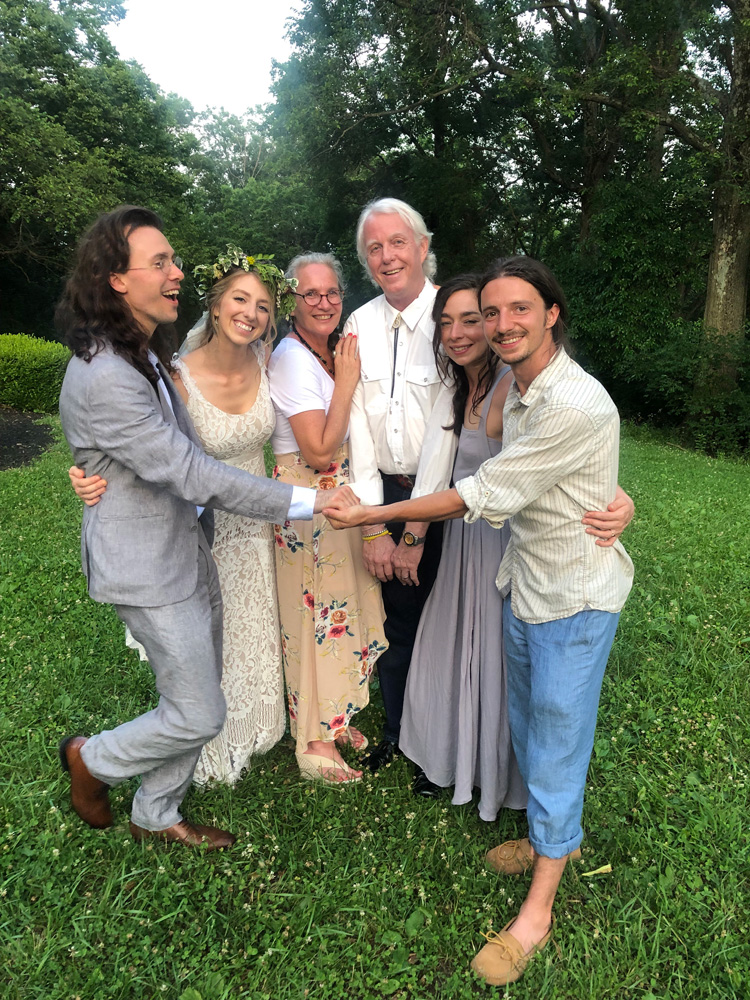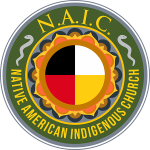NAIC First Time Wedding Officiant
Posted by admin on Oct 6, 2023 in Inter-Tribal Ceremony, Ministry Authorization, NAIC Seminary, NAtive American Indigenous Church, Native Fire Church | 0 comments
An N.A.I.C. Wedding Ceremony Script For First-Time Officiants

N.A.I.C. Church-Tribal Org Wedding
N.A.I.C. Ordained Licentiate-LCHT Ministers are occasionally honored with requests to officiate or perform solemn ceremonies, including weddings, funerals, baptisms, and sweat lodges, among others. For this purpose, I am supplying a guideline for N.A.I.C. Ordained Ministers, L.C.H.T.
While this specific wedding ceremony script contains humorous elements, such as the reading of vows, the exchange of jewelry, and the pouring of the unity sand, you are free to modify it to suit your needs. Have a wonderful wedding!
This standard ceremony-wedding can be indoors or out. Natural surroundings are lovely for exchanging vows. This ceremony can be private or public but must be documented. Dress-up or casual. This is up to the couple to determine.
Processional Conclusions
Minister, “Kindly take a seat.”
Minister: The purpose of our gathering today is to honor [Bride] and [Groom’s] relationship and to be witnesses and supporters of their shared commitment. Collectively, we constitute the most significant individuals in their lives, and they have gathered us here to publicly acknowledge the unique role that each of us has played in the love they share today.
[Bride] and [Groom] wished for me to express their gratitude for your presence and acknowledge the significance of each of you in their relationship. In addition, they would like to recognize those who could not attend today’s event, as they are undoubtedly missed but not forgotten on this day of celebration, [particularly those who have a humorous companion, such as a dog or other animal.]
Regarding influential individuals, [Bride] and [Groom’s] parents were most influential in shaping their lives. Considering this, who gives [Bride] to this man in marriage?
The father responds, “Her mother and I.”
*At this point, the father relinquishes the bride’s arm, embraces her, and hands her over to the groom before seated. Following the bride’s flowers delivery to her lady of honor, the groom and bride stand face-to-face with their hands in hand. They may be standing side-by-side in front of the minister or holding hands at this juncture.
Minister: Marriage provides structure and stability to a couple’s affection. It serves as a means of communicating that regardless of one’s level of slumber or spending at the mall, we are all in this together. [It has greater durability than [Bride’s] charming southern accent, which she has had since their first meeting, and is more permanent than the peculiar tattoo that [Groom] received on his arm in his early twenties.] [Add personal descriptive anecdotes relative to the couple] It is a significant commitment for two individuals: marriage is a declaration to one’s beloved that one will remain together forever.
The foundation of a successful marriage must be this commitment. In a marriage, the “little” matters are the most significant. It is never too elderly to receive a handshake. It takes time to say “I love you” at least once daily. Its anger will never slumber to rest. It is confronting the world while standing united. It is expressing sentiments of gratitude and expressing appreciation in a considerate manner. It consists of the capacity to forget and forgive. They are providing each other with an environment conducive to growth. The pursuit of the good and the attractive is common. Being the correct partner is more than simply marrying the right person.
It has been difficult for [Bride] and [Groom] to arrive at this location today. It has been replete with obstacles for which they were not necessarily prepared. However, they have confronted each block and utilized those experiences to strengthen rather than diminish their love.
Regarding reading
*You may choose any form of literature for this. Additionally, individuals may read it if they so choose. N.A.I.C. suggests the First Nations Version (F.N.V.)
The Minister: The Bible states in the thirteenth chapter of the book of “Corinthians 4-8“, “Love is patient and love is kind.” It is neither envious nor boastful, nor is it arrogant. It is neither impolite nor self-centered; it is not readily angered; and it does not maintain a record of wrongdoings. Rather than taking pleasure in evil, love is ecstatic with the truth. It consistently safeguards, maintains faith, hopes, and perseveres. Love is unfailing.
Examination of the Vows
*Bride, be sure to give these to your lady of honor. *Groom, be sure to have these in your pocket.
Minister: Instruction to: [Bride] and [Groom], the upcoming vows are an opportunity to express your affection and dedication to one another in your own words. Occasionally, poems, verses, and quotations fail to convey the intended meaning, and the most effective solution is to compose the text oneself. The purpose of these vows is an open declaration of your commitment to one another and to all those present today.
[Bride], women prioritize.
The bride reads or recites her vows.
A reading or recitation of the groom’s vows.
Interchange of Rings
Obtain jewelry from the best man and the maid of honor. Please feel free to personalize your communication with one another.
[Bride] and [Groom] will now exchange rings to signify their commitment, as stated by the minister.
Minister: From the humble origins of imperfect metal, rings are fashioned into something remarkable from what was once nothing. Since the ring finger is the sole digit with a vein that runs directly to the heart, it is customarily worn on that finger. By donning the rings, they display an outward manifestation of their commitment to one another.
Minister: [Groom], kindly repeat these words while holding [Bride]’s hand.
Minister: This ring comes to you as a representation of our affection.
The groom presents this ring to you as a representation of our affection.
Minister: For today and tomorrow, as well as every day after that.
Groom: For today and tomorrow and every day after that
Minister: Don’t forget to wear it as a reminder of our commitments on this day.
Groom: Don it as a symbol of our commitment on this day.
Minister: be assured that my affection is present.
Groom: Know that my devotion is present.
Minister: I am not always the case.
Groom: even though I am not.
*The groom places the ring on the bride’s finger.
Minister: [Bride], kindly repeat these words while holding [Groom]’s hand. This ring comes to you as a representation of our affection.
My bride, I present this ring to you as a representation of our affection.
Minister: For today and tomorrow, as well as every day after that.
Bride: for the present and the future, and every day thereafter.
Minister: Don’t forget to wear it as a reminder of our commitments on this day.
Bride: *Don it as a symbol of our commitment to this day.
Bride: My love, respect, and affection are present. Know that my devotion is present even though I am not always perfect in my love. It is my vow to be this way to my best.
*The bride places the ring on the groom’s nail.
Pouring of the Sand of Unity [ Mother Earth and Divine Male and Female elements] or another suitable ritual that encapsulates the concept!
The Minister: By exchanging rings and vows in this location today, you have decided to spend the remainder of your lives together. You are no longer two distinct individuals but rather a married couple. This unity is represented by the pouring of these two separate sand containers. One represents you, [Bride], and everything you possess, are, and will ever have, while the other represents you, [Groom], and everything you own, is, and will ever keep.
In pouring these two sand containers into the third container, the distinct sand containers will be merged into a single entity. In the same way, these sand granules cannot be separated and poured again into their containers; your marriage will remain unified for the duration of your lives.
*Walk over and pour the sand—typically amid music. Another option here is to prepare a small box or container to hold the co-mingled sand as a memory or keep-sake in the home or on the “mantle” place of honor or remembrance.
Concerning the I Dos
*The moment has come to create some enchantment.
Minister: [Bride] and [Groom], you have declared your affection by exchanging vows. The exchange of rings has represented your commitment. And by pouring the “unity sand,” you have communicated the conclusion of your individual lives. Following this, I would like to ask one more question of each of you before we proceed to the reception to celebrate.
Minister: [Bride] in question – Do you consider the groom your spouse and companion in the marriage covenant? If both of you are ill or healthy, do you pledge to be faithful to him for the duration of your lives and to love, console, honor, and keep him?
Bride: I agree.
Groom, do you consider this woman to be your wife and to cohabit by the marriage covenant? Are you committed to cherishing, consoling, preserving, and honoring her regardless of her state of health and illness and to unwaveringly remain devoted to her for the duration of your lives together?
As for the groom, I do.
Minister: I may now pronounce you husband and wife by my authority. You may kiss your fiancée, [Groom].
*It is time to embrace! (Keep it simple, children.)
The Minister: It is a tremendous honor and privilege to be the first to introduce you to Mr. and Mrs. [Full Name of Groom]!
*It is time to organize our celebration, but we must ensure everyone has left the wedding.
Recession Commences
Please note: All NAIC Weddings can incorporate any NAIC Authorized Ceremony or healing ritual as part of the overall wedding ceremony. These observances, such as “Sacred Sweat Lodge,” do not have to happen on the same day but can be scheduled separately.
See also NAIC Doctrine of Faith

